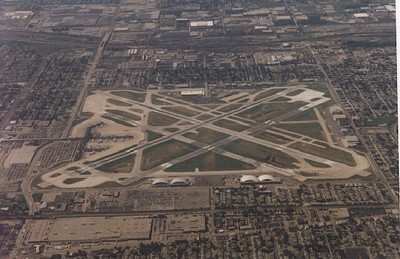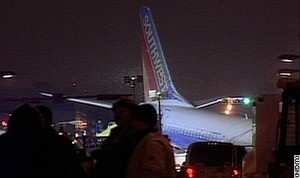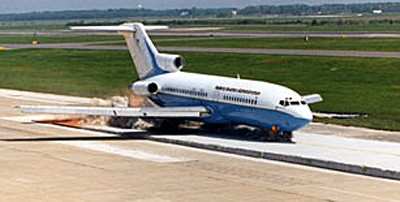Says Autobrakes Distracted Southwest Pilots At Critical
Time
 The National
Transportation Safety Board determined Tuesday the probable cause
of a fatal 2005 runway overrun at Chicago's Midway Airport was the
pilot's failure to use available reverse thrust in a timely manner
to safely slow or stop the airplane after landing. This failure
occurred because the pilots' first experience and lack of
familiarity with the airplane's autobrake system distracted them
from thrust reverser usage during the challenging landing.
The National
Transportation Safety Board determined Tuesday the probable cause
of a fatal 2005 runway overrun at Chicago's Midway Airport was the
pilot's failure to use available reverse thrust in a timely manner
to safely slow or stop the airplane after landing. This failure
occurred because the pilots' first experience and lack of
familiarity with the airplane's autobrake system distracted them
from thrust reverser usage during the challenging landing.
"The urgent recommendation we issued today addressing landing
performance is extremely pertinent to the safe operation of our
aviation system," said NTSB Chairman Mark V. Rosenker. "As we
approach the winter months we continue to push for acceptance of a
minimum safety margin so that this type of accident does not occur
again."
As ANN reported, on December
8, 2005, Southwest Airlines (SWA) flight 1248, a Boeing 737-74H
(N471WN), ran off the departure end of runway 31 center (31C) after
landing in a snow storm at Chicago Midway International Airport
(MDW). The airplane rolled through a blast fence, an airport
perimeter fence, and onto an adjacent roadway... where it struck an
automobile before coming to a stop.
A child in the automobile was killed, while an adult received
serious injuries, and three others received minor injuries.
Eighteen of the 103 persons on board the airplane received minor
injuries, and the airplane itself was substantially damaged.
As outlined in the Board's report, the investigation revealed
that as the crew neared their destination the pilots received mixed
braking action reports for the landing runway. The flight crew used
an on-board laptop performance computer (OPC) provided in the
cockpit of SWA's airplanes to calculate expected landing distance.
They entered multiple scenarios including wind speed and direction,
airplane gross weight at touchdown and reported runway braking
action. Observing OPC indications that they would stop before
the end of the runway with either fair or poor braking action, they
decided that they could safely land at MDW.

However, as stated in the report, the accident pilots were not
aware that stopping margins displayed by the OPC for poor runway
conditions were in some cases based on a lower tailwind component
than that which was presented. Also, the accident pilots were not
aware that the stopping margins computed by the SWA OPC
incorporated the use of thrust reversers for their model aircraft,
the 737-700, which resulted in more favorable stopping margins.
Therefore, the Safety Board concluded in the report had the
pilots known this information, the pilots might have elected to
divert to another airport.
 Contributing to the
accident were Southwest Airlines' failure to provide its pilots
with clear and consistent guidance and training regarding company
policies and procedures related to arrival landing distance
calculations; programming and design of its on board performance
computer, which did not present critical assumption information
despite inconsistent tailwind and reverse thrust assessment
methods; plan to implement new autobrake procedures without a
familiarization period; and failure to include a margin of safety
in the arrival assessment to account for operational
uncertainties.
Contributing to the
accident were Southwest Airlines' failure to provide its pilots
with clear and consistent guidance and training regarding company
policies and procedures related to arrival landing distance
calculations; programming and design of its on board performance
computer, which did not present critical assumption information
despite inconsistent tailwind and reverse thrust assessment
methods; plan to implement new autobrake procedures without a
familiarization period; and failure to include a margin of safety
in the arrival assessment to account for operational
uncertainties.
Contributing to the accident was the pilot's failure to divert
to another airport... given reports that included poor braking
action and a tailwind component greater than five knots at MDW.
Also, contributing to the severity of the accident was the absence
of an engineering materials arresting system (EMAS), which was
needed because of the limited runway safety area beyond the
departure end of runway 31C. As ANN reported, such a
system was installed at the departure end of 31C last November.
On January 27, 2006, the Safety Board issued an urgent Safety
Recommendation to the Federal Aviation Administration (FAA) to
prohibit airlines from using credit for the use of thrust reversers
when calculating stopping distances. In today's report, this
recommendation was classified "Closed-Unacceptable
Action/Superceded" by a new urgent safety recommendation that calls
on the FAA to immediately require operators to conduct arrival
landing distance assessments before every landing based on existing
performance data, actual conditions, and incorporating a minimum
safety margin of 15 percent.
Additional new recommendations to the FAA contained in the final
report include:
- Require all Part 121 and 135 operators to ensure that all on
board electronic devices they use automatically and clearly display
critical performance calculation assumptions.
- Require all Part 121 and 135 operators to provide clear
guidance and training to pilots and dispatchers regarding company
policy on surface condition and braking action reports and the
assumptions affecting landing distance/stopping margin
calculations, to include use of airplane ground deceleration
devices, wind conditions and limits, air distance, and safety
margins.
- Establish a minimum standard for operators to use in
correlating an airplane's braking ability to braking action reports
and runway contaminant type and depth reports for runway surface
conditions worse than bare and dry.
- Develop and issue formal guidance regarding standards and
guidelines for the development, delivery, and interpretations of
runway surface condition reports.

A synopsis of the NTSB's report -- including the probable cause
and recommendations -- is available on the NTSB's website, at the
first FMI link below. The Board's full report will be available on
the website in several weeks.
 ANN's Daily Aero-Linx (04.16.24)
ANN's Daily Aero-Linx (04.16.24) Aero-News: Quote of the Day (04.16.24)
Aero-News: Quote of the Day (04.16.24) Airborne 04.10.24: SnF24!, A50 Heritage Reveal, HeliCycle!, Montaer MC-01
Airborne 04.10.24: SnF24!, A50 Heritage Reveal, HeliCycle!, Montaer MC-01 Airborne 04.12.24: SnF24!, G100UL Is Here, Holy Micro, Plane Tags
Airborne 04.12.24: SnF24!, G100UL Is Here, Holy Micro, Plane Tags Airborne-Flight Training 04.17.24: Feds Need Controllers, Spirit Delay, Redbird
Airborne-Flight Training 04.17.24: Feds Need Controllers, Spirit Delay, Redbird






